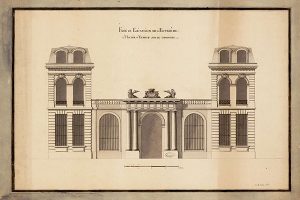
Innocente-Catherine de Rougé, duchess of Elbeuf, author of these Letters, was born into an aristocratic family from Brittany. By the time of the French Revolution, she was already over 80 years old and had enjoyed a very full life, outliving two husbands (to neither of whom she bore children) and accumulating great wealth. She had become duchess of Elbeuf through her second marriage, in 1747, to Emmanuel Maurice de Lorraine (1677–1763), who inherited the ducal title following the death of his unmarried elder brother in 1748. The marriage was a major social promotion for her, allowing her to be presented at court. Evidence suggests that Innocente-Catherine was an astute landowner and businesswoman in her own right, and she funded the couple’s expensive lifestyle. Notably, she owned the magnificent mansion on the Place du Carrousel, opposite the Tuileries palace, which became their residence. Lavishly rebuilt in the 1750s as the Hôtel d’Elbeuf under her direction, the building was mentioned in tourist guides and depicted in engravings. By the time of the Revolution, Innocente-Catherine divided her time between this Paris house and a country estate at Moreuil in Picardy. During the Revolution, many in her elite circle were drawn to emigration, and she herself briefly quit France, leaving her open to accusations of having been an émigré, a life-threatening legal category. For reasons unknown, she returned to Paris, where she was harassed by officials in her neighbourhood, who became aware that she was related through marriage to the Holy Roman Emperor and had family members who were émigrés. Her extreme age may have protected her against the law and police, and she died seemingly of natural causes on 17 February 1794.
For more information on the Letters themselves, go to the The Letters page.
